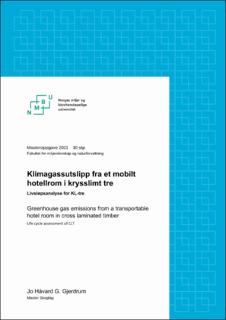| dc.contributor.advisor | Nyrud, Anders Qvale | |
| dc.contributor.author | Gjerdrum, Jo Håvard Grøntoft | |
| dc.coverage.spatial | Norway, Oppland, Gudbrandsdalen, Sør-Fron | en_US |
| dc.date.accessioned | 2021-11-30T09:05:04Z | |
| dc.date.available | 2021-11-30T09:05:04Z | |
| dc.date.issued | 2021 | |
| dc.identifier.uri | https://hdl.handle.net/11250/2832020 | |
| dc.description.abstract | For å bekjempe klimaendringene i verden, kreves samarbeid og mer bruk av trevirke. I turistnæringen i Norge er klimavennlighet og bærekraft viktig. Firmaet Eventyrlige Opplevelser, i Sør-Fron i Gudbrandsdalen, prøver å lage en eventyrlig overnatting for sine gjester. Derfor bygger de ut flyttbare hotellrom i krysslimt tre, som har et forventet lavt klimaavtrykk.
I oppgaven ser en på klimagassutslippet fra konstruksjon av tre ulike hotellromsmoduler. For å beregne klimaavtrykket blir det benyttet analysemetoden livsløpsanalyse (LCA). Det er bare utslipp fra selve konstruksjonen av hotellrommet som er temaet for oppgaven. I tillegg ser en på hvilke påvirkningsfaktorer som er størst og hvilke faktorer som er mulig å gjøre noe med.
For de tre forskjellige modulene, ble det beregnet antall kg CO2-ekvivalenter.
Det totale utslippet fra produksjonen av hotellrommet ble på 208,3 kg CO2-eq for Metode 1, 239,4 kg CO2-eq for Metode 2 og 255,2 kg CO2-eq for den allerede bygde prototypen.
Forutsatt 100 gjestedøgn pr. år, bli utslippet pr. gjestedøgn for Metode 1 på 34,7 gram CO2-eq pr. gjest i hotellrommodulens levetid.
I studien fremkommer et utslipp av KL-treproduksjonen hos Ottadalen Massivtre på 77,15 kg CO2-eq/ m3. Dette viser at KL-tre produksjonen hos Ottadalen Massivtre gir lave utslipp. | en_US |
| dc.description.abstract | Combating climate change in the world requires cooperation and more use of wood. In the tourism industry in Norway, climate friendliness and sustainability are important. The company Eventyrlige Opplevelser, in Sør-Fron in Gudbrandsdalen, is trying to create an adventurous accommodation for its guests. Therefore, they are constructing mobile hotel rooms in cross laminated timber, which has an expected low climate footprint.
The thesis looks at greenhouse gas emissions from the construction of three different hotel room modules. To calculate the climate footprint, the analysis method life cycle analysis (LCA) is used. Only emissions from the actual construction of the hotel room are the subject of the thesis. In addition, one looks at which influencing factors are greatest and which factors it is possible to do something about.
For the three different modules, the number of kg CO2 equivalents was calculated.
The total emissions from the production of the hotel room were 208.3 kg CO2-eq for Method 1, 239.4 kg CO2-eq for Method 2 and 255.2 kg CO2-eq for the already built prototype.
Assuming 100 guest-nights per year, the emission per guest-night for Method 1 is calculated to be 34.7 grams CO2-eq during the lifetime of the hotel room module.
The study shows an emission from CLT production at Ottadalen Massivtre of 77.15 kg CO2-eq/m3. This indicates that CLT production at Ottadalen Massivtre produces low emissions from their product. | en_US |
| dc.language.iso | nob | en_US |
| dc.publisher | Norwegian University of Life Sciences, Ås | en_US |
| dc.rights | Attribution-NonCommercial-NoDerivatives 4.0 Internasjonal | * |
| dc.rights.uri | http://creativecommons.org/licenses/by-nc-nd/4.0/deed.no | * |
| dc.title | Klimagassutslipp fra et mobilt hotellrom i krysslimt tre : livsløpsanalyse for KL-tre | en_US |
| dc.title.alternative | Greenhouse gas emissions from a transportable hotel room in cross laminated timber : life cycle assessment of CLT | en_US |
| dc.type | Master thesis | en_US |
| dc.description.localcode | M-SF | en_US |

